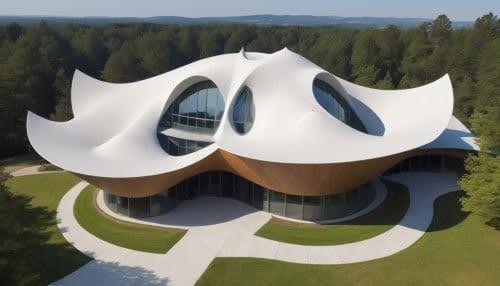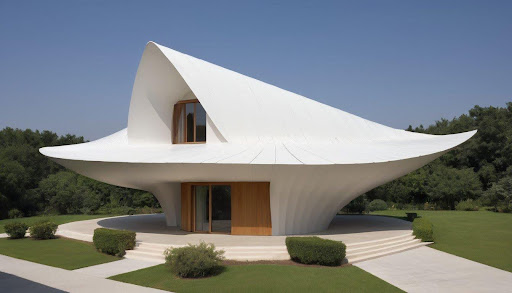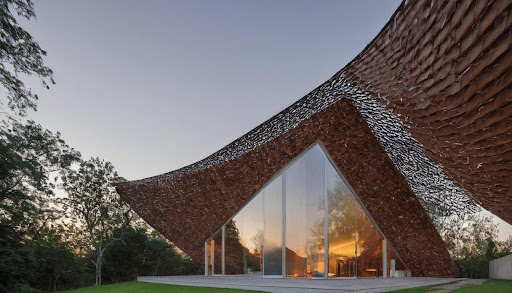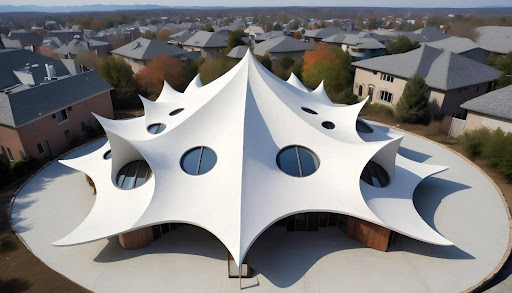Curves in the Sky: The Beauty of Hyperbolic Roofs
Introduction

In the ever-evolving landscape of architecture, hyperbolic roofs stand out as a testament to innovation and creativity. Unlike conventional roofing structures such as metal roofing, wood roofing, tile roofing, or asphalt roofing, hyperbolic roofs embody a distinctive curvature that defies traditional geometric norms. These roofs, characterized by their gracefully sweeping lines and striking profiles, offer not only aesthetic appeal but also unparalleled structural integrity.
Hyperbolic roofs trace their origins to the fascinating realm of hyperbolic geometry, where mathematical principles intersect with architectural design. As architects and engineers push the boundaries of possibility, hyperbolic roofs have emerged as iconic symbols of modernity and progress. They adorn skylines, museums, and public spaces, leaving an indelible mark on the built environment.
In this exploration, we embark on a journey to unravel the allure of hyperbolic roofs. From their historical roots to contemporary applications, we delve into the design, construction, and significance of these architectural marvels, celebrating their timeless elegance and ingenuity.
Importance of Hyperbolic Roofs

Unique Aesthetic Appeal: Hyperbolic roofs offer a departure from conventional roof shapes like gabled roof, pitched roof, or flat roof, providing buildings with a distinctive and visually striking appearance.
Structural Efficiency
The hyperbolic form inherently distributed loads across its surface, resulting in enhanced structural integrity compared to traditional roof shapes. This efficiency reduces the need for additional support structures and materials, contributing to cost savings and construction efficiency.
Optimized Drainage
The curvature of hyperbolic roofs naturally facilitates water runoff, minimizing the risk of ponding and water damage. This feature is especially advantageous in regions prone to heavy rainfall or snow accumulation, where proper drainage is crucial for maintaining the integrity of the building envelope.
Increased Interior Space
Unlike sloped roof shapes such as pitched or gabled roofs, hyperbolic roofs offer more usable interior space with their expansive, sweeping curves. This extra space can be utilized for various purposes, from creating spacious living areas in residential buildings to accommodating large gathering spaces in commercial structures.
Enhanced Natural Lighting
The curved surface of hyperbolic roofs allows for innovative design opportunities to incorporate skylights and clerestory windows, maximizing natural light penetration into interior spaces. This feature promotes energy efficiency by reducing the need for artificial lighting during daylight hours, while also creating a more pleasant and inviting indoor environment.
Architectural Versatility
Hyperbolic roofs can be adapted to a wide range of architectural styles and building types, from modernist masterpieces to historic renovations. Their flexibility in design allows architects to explore creative expressions while meeting functional requirements, making them a versatile choice for diverse projects.
Symbolism and Identity
The unique silhouette of hyperbolic roofs can become iconic symbols of a building or community, conveying a sense of identity and pride. Whether gracing the skyline of a city or adorning the roofline of a cultural landmark, hyperbolic roofs leave a lasting impression, becoming integral parts of the built environment.
Hyperbolic Roof techniques

Traditional Framework Approach
- Utilizes a framework of trusses or beams to support the hyperbolic shape.
- Requires careful calculation and precision to ensure proper load distribution.
- Commonly used for smaller-scale hyperbolic roofs in residential or commercial buildings.
Tensioned Fabric Structures
- Employs high-strength fabrics stretched over a framework to create the hyperbolic form.
- Offers flexibility and cost-effectiveness for temporary or semi-permanent structures.
- Popular choice for event pavilions, sports facilities, and outdoor venues.
Shell Structures
- Constructed using reinforced concrete or thin-shell materials to achieve the hyperbolic curvature.
- Requires formwork or molds to shape the structure during construction.
- Ideal for large-span roofs in arenas, airports, and industrial buildings.
Grid Shell Systems
- Consists of a network of intersecting beams arranged in a grid pattern to form the hyperbolic shape.
- Provides strength and stability while allowing for lightweight construction.
- Widely used in contemporary architecture for its structural efficiency and aesthetic appeal.
Digital Fabrication Techniques
- Utilizes advanced digital modeling and fabrication technologies such as 3D printing or CNC machining.
- Enables precise customization and optimization of hyperbolic roof components.
- Emerging as a cutting-edge approach for experimental and bespoke architectural projects.
Future Trends and Innovations

As the architectural landscape continues to evolve, hyperbolic roof design emerges as a focal point for innovation and advancement. From materials to construction techniques, the future of hyperbolic roofs promises exciting developments that will shape the way we perceive and interact with built environments.
One of the emerging trends in hyperbolic roof design is the integration of advanced materials such as composite panels and engineered timber. These materials offer enhanced strength-to-weight ratios and allow for greater design flexibility, enabling architects to push the boundaries of form and function. Additionally, innovations in construction techniques, including digital fabrication and modular assembly, streamline the building process and reduce construction time and costs.
The potential impact of these advancements extends beyond mere aesthetics. Hyperbolic roofs equipped with modern features like integrated soffits fascia, drip edges, drip edges offer improved weather resistance and energy efficiency. Furthermore, the incorporation of valleys enhances drainage systems, minimizing water accumulation and prolonging the lifespan of the structure.
In the realm of urban planning, hyperbolic roofs present new opportunities for sustainable development and community engagement. Their striking profiles and innovative design elements can redefine skylines, creating iconic landmarks that inspire and unite communities. Moreover, the integration of green roof technologies with hyperbolic designs promotes environmental stewardship and urban biodiversity, contributing to healthier and more resilient cities.
In conclusion, the future of hyperbolic roof design holds immense promise, driven by advancements in materials, construction techniques, and their potential impact on architecture and urban planning. By embracing these trends and innovations, architects and urban planners can create vibrant, sustainable, and resilient built environments that enrich the lives of people around the world.
Conclusion

In conclusion, hyperbolic roofs stand as emblematic symbols of architectural innovation and design excellence. Their graceful curves, structural efficiency, and versatile applications have reshaped the skyline of cities worldwide. With advancements in materials, construction techniques, and sustainable practices, hyperbolic roofs continue to inspire awe and admiration while meeting the evolving needs of modern society. As we look to the future, these iconic structures will undoubtedly remain at the forefront of architectural exploration and creativity.
